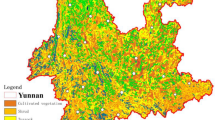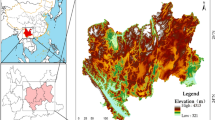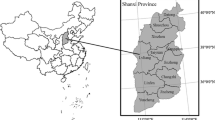Abstract
Climate change has an impact on forest fire patterns. In the context of global warming, it is important to study the possible effects of climate change on forest fires, carbon emission reductions, carbon sink effects, forest fire management, and sustainable development of forest ecosystems. This study is based on MODIS active fire data from 2001–2020 and the influence of climate, topography, vegetation, and social factors were integrated. Temperature and precipitation information from different scenarios of the BCC-CSM2-MR climate model were used as future climate data. Under climate change scenarios of a sustainable low development path and a high conventional development path, the extreme gradient boosting model predicted the spatial distribution of forest fire occurrence in China in the 2030s (2021–2040), 2050s (2041–2060), 2070s (2061–2080), and 2090s (2081–2100). Probability maps were generated and tested using ROC curves. The results show that: (1) the area under the ROC curve of training data (70%) and validation data (30%) were 0.8465 and 0.8171, respectively, indicating that the model can reasonably predict the occurrence of forest fire in the study area; (2) temperature, elevation, and precipitation were strongly correlated with fire occurrence, while land type, slope, distance from settlements and roads, and slope direction were less strongly correlated; and, (3) based on future climate change scenarios, the probability of forest fire occurrence will tend to shift from the south to the center of the country. Compared with the current climate (2001–2020), the occurrence of forest fires in 2021–2040, 2041–2060, 2061–2080, and 2081–2100 will increase significantly in Henan Province (Luoyang, Nanyang, Sanmenxia), Shaanxi Province (Shangluo, Ankang), Sichuan Province (Mianyang, Guangyuan, Ganzi), Tibet Autonomous Region (Shannan, Linzhi, Changdu), Liaoning Province (Liaoyang, Fushun, Dandong).








Similar content being viewed by others
Data availability
The MODIS active fire data came from NASA’s FIRMS (https://earthdata.nasa.gov); the DEM, POP, GDP data came from the Resources and Environment Data Center of CAS (https://www.resdc.cn). The datasets for roads and residential areas were downloaded from the National Geographic Information Resource Catalog System (https://www.webmap.cn). The Chinese vegetation cover map came from Big Earth Data for Three Poles (http://poles.tpdc.ac.cn/zh-hans/). The carbon emission scenarios were obtained from the World Climate website (http://worldclim.org/); We acknowledge the World Climate Research Program.
Change history
04 May 2023
The original version is updated due to funding text that has been inadvertently appeared twice.
References
Adams MA, Shen Z (2015) Introduction to the characteristics, impacts and management of forest fires in China. For Ecol Manag 356:1–1
Baskent EZ, Keles S (2009) Developing alternative forest management planning strategies incorporating timber, water and carbon values: an examination of their interactions. Environ Model Assess 14(4):467–480
Chen M, Liu Q, Zhang J, Chen S, Zhang C (2020) XGBoost-based algorithm for post-fault transient stability status prediction. Power Syst Technol 44(03):1026–1034
Chen T, Guestrin C (2016) XGBoost: A scalable tree boosting system. The 22nd ACM SIGKDD International Conference.
Clark JS (1988) Effect of climate on fire regimes in northwestern Minesota. Nature 334:233–235
Davies D, Ilavajhala S, Wong M, Justice C (2009) Fire information for resource management system: archiving and distributing MODIS active fire data. Geosci Remote Sens IEEE Trans 47:72–79
DeLucia EH, Hamilton JG, Naidu SL, Thomas RB, Andrews JA, Finzi A, Lavine M, Matamala R, Mohan JE, Hendrey GR (1999) Net primary production of a forest ecosystem with experimental CO2 enrichment. Science 284(5417):1177–1179
Eyring V, Bony S, Meehl GA, Senior CA, Stevens B, Stouffer RJ, Taylor KE (2016) Overview of the coupled model intercomparison project phase 6 (CMIP6) experimental design and organization. Geosci Model Dev 9(5):1937–1958
Gao J (2015) Middle and long term plan discussion of key problems to forest fire prevention in China. Forest Inventory and Planning 40(01):45–47+52 (in Chinese)
Gu X, Wu Z, Zhang Y, Yan S, Fu J, Du L (2020) Prediction research of forest fires in Jiangxi province in the background of climate change. Acta Ecol Sin 40(02):667–677
Hantson S, Padilla M, Corti D, Chuvieco E (2013) Strengths and weaknesses of MODIS hotspots to characterize global fire occurrence. Remote Sens Environ 131:152–159
Hawbaker TJ, Radeloff VC, Stewart SI, Hammer RB, Keuler NS, Clayton MK (2013) Human and biophysical influences on fire occurrence in the United States. Ecol Appl 23(3):565–582
He Q, Wang M, Liu K, Li K, Jiang Z (2021) GPRChinaTemp1km: a high-resolution monthly air temperature dataset for China (1951–2020) based on machine learning. Earth Syst Sci Data 14(7):3273–3292. https://doi.org/10.5194/essd-14-3273-2022
Hu H, Wei S, Wei S, Sun L (2012) Effect of fire disturbance on forest ecosystem carbon cycle under the background of climate warming. J Catastrophol 27(04):37–41 (in Chinese)
Hu Y, Zhao FJ, Chen F, Shu LF (2021) Impacts of global warming and large-scale climate fluctuation on forest fires and forest carbon emissions. Terr Ecosyst Conserv 1(01):75–81 (in Chinese)
Hurtt GC, Chini L, Sahajpal R, Frolking S, Bodirsky BL, Calvin K, Doelman JC, Fisk J, Fujimori S, Klein Goldewijk K, Hasegawa T, Havlik P, Heinimann A, Humpenöder F, Jungclaus J, Kaplan J, Kennedy J, Krisztin T, Lawrence D, Lawrence P, Ma L, Mertz O, Pongratz J, Popp A, Poulter B, Riahi K, Shevliakova E, Stehfest E, Thornton P, Tubiello FN, van Vuuren DP, Zhang X (2020) Harmonization of global land use change and management for the period 850–2100 (LUH2) for CMIP6. Geosci Model Dev 13(11):5425–5464
Jiang J (1999) National basic GIS 1:250,000 database design and application study. Remote Sens Inf 04:14–18 (in Chinese)
Jin H, Ling CX (2005) Using AUC and accuracy in evaluating learning algorithms. IEEE Trans Knowl Data Eng 17(3):299–310
Johnstone JF, Chapin F, Hollingsworth TN, Mack MC, Romanovsky V, Turetsky M (2010) Fire, climate change, and forest resilience in interior Alaska. Can J for Res 40:1197–1209
Kastridis A, Stathis D, Sapountzis M, Theodosiou G (2022) Insect outbreak and long-term post-fire effects on soil erosion in Mediterranean suburban forest. Land 11(6):911
Kong F, Sun S (2021) Spatial differentiation prediction of global land extreme precipitation intensity based on SSPs. J Catastrophol. 36(04):107–112+118 (in Chinese)
Li C, Flannigan MD, Corns IGW (2000) Influence of potential climate change on forest landscape dynamics of west-central Alberta. Can J For Res 30:1905–1912
Li X, Wu W, Zhang C, Guo R (2011) Influence of climate change on north-eastern of lnner Mongolia grassland forest fire. J Arid Land Res and Environ 25(11):6 (in Chinese)
Liu Z, Li T (2019) Global warming trend accelerates sharply. Ecological Economy 35(09):1–4
Liu B, Xu M, Henderson M, Qi Y, Li Y (2004) Taking China’s temperature: daily range, warming trends, and regional variations, 1955–2000. J Clim 17(22):4453–4462
Liu H, Jiang D, Yang X, Luo C (2005) Spatialization approach to 1 km grid GDP supported by remote sensing. Geo-Inf Sci 7:120–123
Liu Y, Stanturf J, Goodrick S (2010) Trends in global wildfire potential in a changing climate. For Ecol Manag 259(4):685–697
Liu Z, Yang J, Chang Y, Weisberg PJ, He HS (2012) Spatial patterns and drivers of fire occurrence and its future trend under climate change in a boreal forest of Northeast China. Glob Change Biol 18(6):2041–2056
Liu C, Zhang H, Wu J (2021) Impact assessment of extreme precipitation in China under SSPs scenario. Environ Prot 49(08):29–34 (in Chinese)
Lucht W, Prentice CI, Myneni RB, Sitch S, FriedLingstein P (2002) Climatic control of the high-Latitude vegetation greening trend and pinatubo effect. Science 296(5573):1687–1689
Ma W, Feng Z, Cheng Z, Chen S, Wang F (2020) Identifying forest fire driving factors and related impacts in China using random forest algorithm. Forests 5:1–26
Margiorou S, Kastridis A, Sapountzis M (2022) Pre/post-fire soil erosion and evaluation of check-dams effectiveness in mediterranean suburban catchments based on field measurements and modeling. Land 11:1705. https://doi.org/10.3390/land11101705
Naderpour M, Rizeei HM, Khakzad N, Pradhan B (2019) Forest fire induced Natech risk assessment: a survey of geospatial technologies. Reliab Eng Syst Saf 191:106558
Neary DG, Klopatek CC, Debano LF, Ffolliott PF (1999) Fire effects on belowground sustainability: a review and synthesis. For Ecol Manag 122:51–71
Price C, Rind D (1994) Possible implications of global climate change on global lightning distributions and frequencies. J Geophy Res Atmos 99(D5):10823–10831
Qiu Z, Feng Z, Song Y, Li M, Zhang P (2020) Carbon sequestration potential of forest vegetation in China from 2003 to 2050: predicting forest vegetation growth based on climate and the environment. J Clean Prod 252:119715
Qu L, Zhu Q, Zhu C, Zhang J. (2020) Monthly precipitation data set with 1 km resolution in China from 1960 to 2020. Science Data Bank; [accessed]. Mar. 22, 2022 [Online]. Available: https://doi.org/10.11922/sciencedb.01607. [Accessed: Jan. 04, 2022].
Ran YH, Li X, Lu L, Li ZY (2012) Large-scale land cover mapping with the integration of multi-source information based on the Dempster-Shafer theory. Int J Geogr Inf Sci 26(1–2):169–191
Shao Y, Feng Z, Sun L, Yang X, Li Y, Xu B, Chen Y (2022a) Mapping China’s risks of forest fire with machine learning. Forests 13(6):856
Shao Y, Wang Z, Feng Z, Sun L, Yang X, Zheng J, Ma T (2022) Assessment of China’s forest fire occurrence with deep learning, geographic information and multisource data. J Forestry Res. https://doi.org/10.1007/s11676-022-01559-1
Shaohong WU, Du Z, Yunhe Y, Erda L, Yinlong XU (2010) Northward-shift of temperature zones in China’s eco-geographical study under future climate scenario. J Geog Sci 20(5):9
Shaojun H, Jin C, Ruixu G, Guijun W. (2012) The capability analysis on the characteristic selection algorithm of text categorization based on F1 measure value. In: Proceedings of the 2012 Second International Conference on Instrumentation, Measurement, Computer, Communication and Control.
Sun L, Wang Q, Wei S, Hu H, Guan D, Chen X (2014) Response characteristics and prospect of forest fire disasters in the context of climate change in China. J Catastrophol 29(01):12–17 (in Chinese)
Syafrullah M, Salim NB. (2011) Using particle swarm optimization to improve the precision and recall of taxonomy extraction.In: Proceedings of the 2011 IEEE 9th international conference on dependable, autonomic and secure computing.
Szpakowski DM, Jensen JLR (2019) A review of the applications of remote sensing in fire ecology. Remote Sens 11(22):2638
Wang M, Shu L, Wang J, Tian X, Li H (2007) Forest fuel characteristics and the impact of climate change on forest fires in southeast tibet. Fire Safe Sci 1:15–20 (in Chinese)
Wang X, Zhang L, Li J, Sun Y, Tian J, Han R (2020) Study on xgboost improved method based on genetic algorithm and random forest. Comput Sci 47(S2):454–458+463 (in Chinese)
Wittenberg L, Malkinson D, Barzilai R (2014) The differential response of surface runoff and sediment loss to wildfire events. CATENA 121:241–247
Wotton M, Nock C, Flannigan M (2010) Forest fire occurrence and climate change in Canada. Int J Wildland Fire 19:253–271
Wu Z (2020) Prediction research of the forest fire in Jiangxi province in the background of climate change. Acta Ecol Sin 40(2):667–667
Wu Z, He HS, Keane RE, Zhu Z, Wang Y, Shan Y (2020) Current and future patterns of forest fire occurrence in China. Int J Wildland Fire 29:104–109
Xin XG, Wu TW, Zhang J, Zhang F, Li WP, Zhang YW, Liu QX, Fang YJ, Jie WH, Zhang L, Dong M, Shi XL, Li JL, Chu M, Liu QX, Yan JH (2019) Introduction of BCC models and its participation in CMIP6. Adv Clim Chang Res 15(5):533–539 (in Chinese)
Xu Y, Zhen J, Jiang X, Wang J (2021) Mangrove species classification with UAV-based remote sensing data and XGBoost. Nat Remote Sens Bull 25(03):737–752
Xu X (2017) Spatial distribution of China’s population in km grid dataset. Resource and environmental science data registration and publication system; [accessed]. (http://www.resdc.cn/DOI),2017. https://doi.org/10.12078/2017121101.
Yang G, Pei Y, Song M (2021) Evaluation and projection of precipitation in southwestern China using CMIP6 models. Open J Nat Sci 9(6):910–920 (in Chinese)
Yue C, Luo C, Shu L, Shen Z (2020) A review on wildfire studies in the context of global change. Acta Ecol Sin 40(02):385–401
Zhang S, Zhu C, Chen Z (2000) Research on forest fire meteorological environmental elements and large forest fires. J Nat Disasters 02:111–117 (in Chinese)
Zhang Y, Qin D, Yuan W, Jia B (2016) Historical trends of forest fires and carbon emissions in China from 1988 to 2012: fire trends and carbon emissions. J Geophys Res-Biogeo 121(9):2506–2517
Zhao F, Shu L (2007) Study on the impact of climate anomalies on the occurrence of forest fires. Forest Fire Prev 01(1):21–23 (in Chinese)
Acknowledgements
We would like to thank the editors and reviewers for their valuable opinions and suggestions that improved this research.
Author information
Authors and Affiliations
Contributions
Conceptualization, GF, ZF and YS; data curation, YS and GF; formal analysis, YS and GF; funding acquisition, GF and ZF; investigation, YS and GF; methodology, ZF, YS and GF; project administration, GF, ZF and YS; resources, GF, ZF and YS; supervision, YS, GF and ZF; validation, GF, ZF, YS, LS, XY, TM, HF, and AW; visualization, YS and GF; writing—original draft, Y.S. and G.F.; writing—review and editing, YS, GF, ZF, LS, XY, TM, HF, and AW All authors have read and agreed to the published version of the manuscript.
Corresponding author
Ethics declarations
Conflicts of Interest
The authors declare no conflict of interest.
Additional information
Publisher's Note
Springer Nature remains neutral with regard to jurisdictional claims in published maps and institutional affiliations.
Project funding: This research was funded by the National Postdoctoral Innovative Talents Support Plan China Postdoctoral Science Foundation (BX20220038) and Key R & D Projects in Hainan Province (ZDYF2021SHFZ256).
The online version is available at https://link.springer.com/.
Corresponding editor: Yu Lei.
Rights and permissions
Springer Nature or its licensor (e.g. a society or other partner) holds exclusive rights to this article under a publishing agreement with the author(s) or other rightsholder(s); author self-archiving of the accepted manuscript version of this article is solely governed by the terms of such publishing agreement and applicable law.
About this article
Cite this article
Shao, Y., Fan, G., Feng, Z. et al. Prediction of forest fire occurrence in China under climate change scenarios. J. For. Res. 34, 1217–1228 (2023). https://doi.org/10.1007/s11676-023-01605-6
Received:
Accepted:
Published:
Issue Date:
DOI: https://doi.org/10.1007/s11676-023-01605-6




